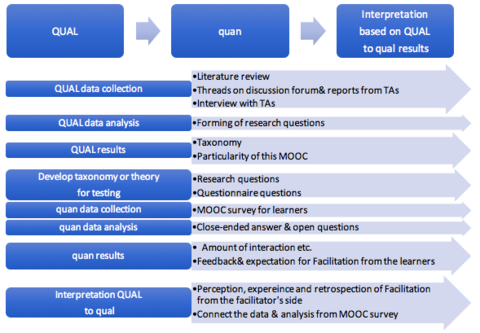BLOG & NEWS
2018.04.26
【今年度の研究計画】文字式におけるプロセプト的思考を支援するゲーム教材の開発と評価
こんにちは!3年目だけど1度目の修士2年、花嶋陽です。
自分の研究テーマは、「数学が不得意な生徒への学習支援」で、修士研究では「文字式」を対象としています。
xとかyとかその辺のやつです。
これは、中学以降の数学においてずっと必要となりますし、使えるようになればとっても便利なんですが、
どうしてもここでつまずいてしまう生徒が多いと言われています。
なので、自分の研究では中学1年生の最初に習う、最も基本的な文字式の学習(1次式の計算や表現など)における支援を行いたいと思っています。
具体的には、数学学習において重要とされているプロセプト的思考の獲得を支援するようなゲーム教材の開発を考えています。
プロセプト的思考とは、D.Tallにより提唱されているもので、数学的記号を計算過程(プロセス)としても、その結果としての概念(コンセプト)及び対象物としても柔軟に切り替えてみれること(プロセプト(=プロセス+コンセプト)的思考)です。
具体的に文字式において見てみると、例えば
3x+2は、
・「3とxをかけて、2を足す」という計算過程
・その計算をした結果としての「一つの数」
という二つの見方ができます。
そして、文字式においてつまずきが見られる生徒は、3x+2を計算過程としてしか見れないがゆえに困難が生じているということが言われています。
例えば、
・8x+4-6x+1 = 2x+5 = 7x
このような誤答が起こるのですが、これは2x+5を「それ自体一つの数として見れず、まだ計算の途中としてしか見れないため、無理やり2x+5を『計算』してしまい、7xとする」というような生徒の認識的なつまずきが隠れています。
他にも、以下のような問題において、解答できない生徒は、そもそもa+2本やa-2本を「数」として見れないため、(a+2)+(a-2)のような立式自体ができないという困難性があります。

このような困難性に対して、文字式を計算過程としてだけでなく、「一つの数」として2とか3のような具体的な数と同様に扱えるようにすることが、本研究の支援目標となります。
そして、その支援方法として、視覚的なフィードバックや真正性の高い試行錯誤が行えるゲームという形態を選び、その開発と評価を行うことが私の研究計画となります。
数学でつまずいてしまう生徒や、そういった生徒にどうアプローチすればいいか模索していらっしゃる先生方への一助となれば幸いです。
【修士2年 花嶋陽】
2018.04.15
【Research Plan】Facilitation for Learning Community in Large-scale Online Learning Environment: a case study on Studying at Japanese Universities (M2 ZHOU Qiaochu)
Hi everyone! This is Qiaochu. Glad to write the first blog for this new semester. Right now, I am diving into the data analysis of my research and preparing for the thesis writing. As professor said, 70 % of the workloads may have been done but the last 30% is another challenge to go. This is quite right and therefore I need to optimize my time and schedule for the writing process.
You may have already noticed that finally I adjusted the research theme to "facilitation". Focusing on this, case study on one MOOC is adopted to explore facilitation in MOOC's online learning environment. And this time I will briefly introduce my research methods and progress of the research, with some preliminary analysis we got so far.
So, the MOOC of "Studying at Japanese Universities" by the University of Tokyo on Coursera will be researched as an information-oriented course. Being a representative case embodying the role of facilitation in MOOC learning context, "Studying at Japanese Universities" also features the particularity as an informative course, with over 10000 global online learners. With high rating (4.7/5) on Cousera, data accessibility, and active interaction, this course is worth researching for MOOCs' development in the long run.
Mixed methods of combining qualitative and quantitative research are adopted while the whole study is qualitatively emphasized. The research is of exploratory design when quantitative research follows qualitative part. The detailed process is attached below. Till now, interviews with facilitators of the MOOC and survey regarding facilitation in this MOOC for enrolled online learners have been finished. The next step is doing interpretation based on both the qualitative and quantitative research.
The MOOC survey to enrolled online learners was conducted in March. With every respondent's kind help, we got 64 responses in around two weeks. Basically, we see online learners express positive feedback towards facilitation from TAs in the MOOC. While on the other hand, the problem of insufficient interaction and the gap between "silent" learner and super-active learner also remain as a distinct problem. In the meantime, the diversity of MOOC online learners and their differed needs also add difficulty to online facilitation.
Quantitative analysis can be a tricky task. While it may be "convenient" to extract conclusions from the data, variables need careful observation for comprehensive analysis. Right now, I am looking into open questions we gathered from learners for more hints.
Finally, hope everyone's having a good start in the great season and I shall also try my best for the thesis. See you next time!
【Qiaochu】
最新記事
BLOG & NEWS
2006
- 6
- 7
- 8
- 9
- 10
- 11
- 12
- 1
- 2
- 3
- 4
- 5
- 6
- 7
- 8
- 9
- 10
- 11
- 12
- 1
- 2
- 3
- 4
- 5
- 6
- 7
- 8
- 9
- 10
- 11
- 12
- 1
- 2
- 3
- 4
- 5
- 6
- 7
- 8
- 9
- 10
- 11
- 12
- 1
- 2
- 3
- 4
- 5
- 6
- 7
- 8
- 9
- 10
- 11
- 12
- 1
- 2
- 3
- 4
- 5
- 6
- 7
- 8
- 9
- 10
- 11
- 12
- 1
- 2
- 3
- 4
- 5
- 6
- 7
- 8
- 9
- 10
- 11
- 12
- 1
- 2
- 3
- 4
- 5
- 6
- 7
- 8
- 9
- 10
- 11
- 12
- 1
- 2
- 3
- 4
- 5
- 6
- 7
- 8
- 9
- 10
- 11
- 12
- 1
- 2
- 3
- 4
- 5
- 6
- 7
- 8
- 9
- 10
- 11
- 12
- 1
- 2
- 3
- 4
- 5
- 6
- 7
- 8
- 9
- 10
- 11
- 12
- 1
- 2
- 3
- 4
- 5
- 6
- 7
- 8
- 9
- 10
- 11
- 1
- 2
- 3
- 4
- 5
- 6
- 7
- 9
- 10
- 11
- 12
- 2
- 3
- 4
- 5
- 6
- 7
- 10
- 3
- 4
- 5
- 6
- 7
- 8
- 9
- 10
- 11
- 12
- 2
- 3
- 4
- 5
- 6
- 7
- 8
- 10
- 11
- 12
- 1
- 2
- 3
- 4
- 5
- 6
- 9
- 10
- 12
- 1
- 4
- 5
- 6
- 7
- 10
- 2
- 3
- 4
- 6
- 10
- 11
- 12
- 2
- 4
- 5
- 6
- 7
- 9
- 10

